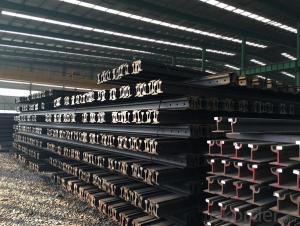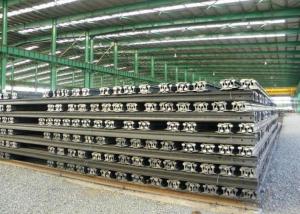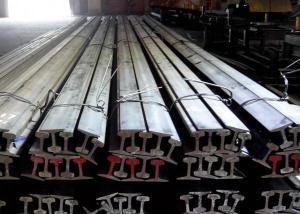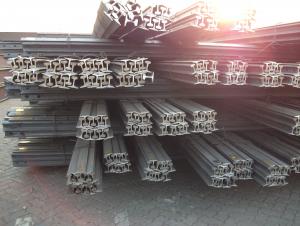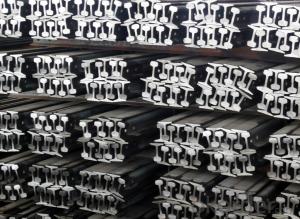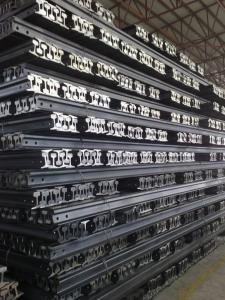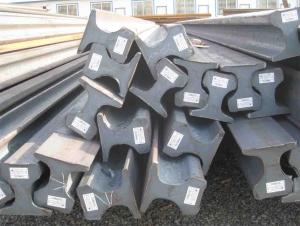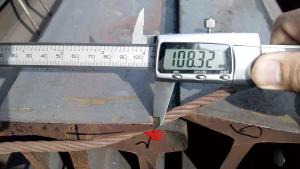Hot Rolled Light Steel Rail for Warehouse ,Minas, Structures
- Loading Port:
- Tianjin
- Payment Terms:
- TT or LC
- Min Order Qty:
- 25 m.t.
- Supply Capability:
- 2000000 m.t./month
OKorder Service Pledge
OKorder Financial Service
You Might Also Like
Specifications of Hot Rolled Light Steel Rail for Warehouse ,Minas, Structures
Product Name: High Quality Steel Rail
Production Standard: GB, AREMA, JIS, DIN, EN, UIC, BS, etc.
Grade: Q235B, 55Q, 900A, 1100A, 50MN, U71MN, R260.
Place of Origin: China
Length: 6M-24M according to the requriements of the customers.
Grade | Element(%) | ||||
C
| Mn | S
| P
| Si
| |
55Q
|
0.50—0.60 |
0.70—1.00 |
≤0.050 |
≤0.045
|
0.15-0.35
|
Applications of Hot Rolled Light Steel Rail for Warehouse ,Minas, Structures
Light rail is mainly used in forest region, mines, factories and construction sites laid of the place such as temporary transport line and light motorcycles with line.
Heavy rail is suitable for the laying of main trunk line of the curves and the orbit of the tunnel can also be used for tower crane and other crane track.
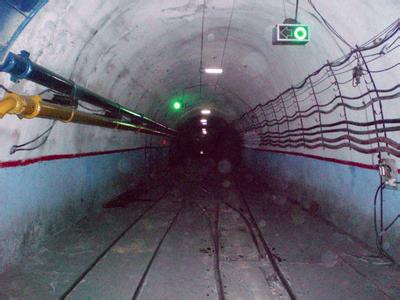
Packaging & Delivery of Hot Rolled Light Steel Rail for Warehouse ,Minas, Structures
1. Packing: it is nude packed in bundles by steel wire rod
2. Bundle weight: not more than 3.5MT for bulk vessel; less than 3 MT for container load
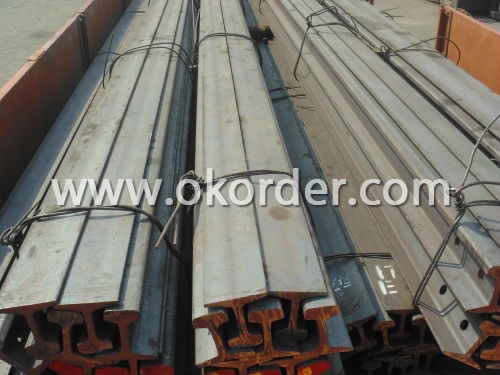
3. Marks:
Color marking: There will be color marking on both end of the bundle for the cargo delivered by bulk vessel. That makes it easily to distinguish at the destination port.
Tag mark: there will be tag mark tied up on the bundles. The information usually including supplier logo and name, product name, made in China, shipping marks and other information request by the customer.
If loading by container the marking is not needed, but we will prepare it as customer request.
4. Transportation: the goods are delivered by truck from mill to loading port, the maximum quantity can be loaded is around 40MTs by each truck. If the order quantity cannot reach the full truck loaded, the transportation cost per ton will be little higher than full load.
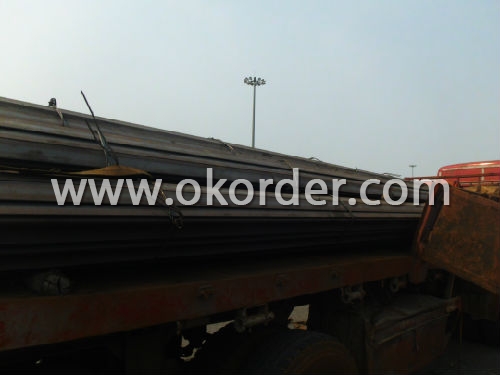
5. Delivered by container or bulk vessel
6. Delivery Time: All the Hot Rolled Steel Rail will be transpoted at the port of Tianjin, China within 30 days after receiving the advance payment by T/T or the orginal L/C at sight.
7. Invoicing on theoretical weight or actual weight as customer request
8. Payment terms: 30% advance payment by T/T, 70% payment against the copy of the B/L; 100% L/C at sight, etc.
Inspection of Hot Rolled Light Steel Rail for Warehouse ,Minas, Structures
We will send the MTC of the factory to the clients directly which contains the anlisis of the heat, chemiqual composition, phisical characteristicas, etc.
And our inspectors will arrive at the factory to meke the inspection of the size, length, weight and quantity before the transportation from the factory.
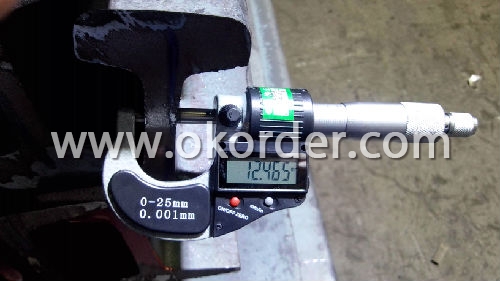
FAQ:
Q1: Why buy Materials & Equipment from OKorder.com?
A1: All products offered byOKorder.com are carefully selected from China's most reliable manufacturing enterprises. Through its ISO certifications, OKorder.com adheres to the highest standards and a commitment to supply chain safety and customer satisfaction.
Q3: What is the normal tolerance of Hot Rolled Mild Steel Angle Beams for Structures and for Buildings?
A3: Normally 3%-5%, but we can also produce the goods according to the customers' requests.
Q3: How soon can we receive the product after purchase?
A3: Within three days of placing an order, we will begin production. The specific shipping date is dependent upon international and government factors, but is typically 7 to 10 workdays.
- Q:What are the environmental impacts of steel rail manufacturing?
- The environmental impacts of steel rail manufacturing include the extraction and processing of raw materials, such as iron ore and coal, which contribute to deforestation, habitat destruction, and air and water pollution. The energy-intensive production process emits greenhouse gases and releases pollutants into the atmosphere and water systems. Additionally, the transportation of materials and finished products can result in further carbon emissions and habitat disruption. Efforts are being made to mitigate these impacts through sustainable practices and technologies, but the industry still has a significant environmental footprint.
- Q:What are the potential risks of using steel rails?
- There are several potential risks associated with using steel rails. One major risk is the potential for corrosion. Steel is susceptible to rusting, especially when exposed to moisture and certain environmental conditions. Corrosion can weaken the rails, making them more prone to damage and breakage. This poses a significant safety hazard as it can lead to derailments and accidents. Another risk is the potential for fatigue failure. Steel rails experience constant stress and strain from the weight and movement of trains. Over time, this can lead to the development of cracks and fractures in the rails, known as fatigue failure. If not detected and repaired in a timely manner, these cracks can grow and eventually cause catastrophic failures. Furthermore, steel rails are also subject to wear and tear from the constant friction between the train wheels and the rail surface. This can result in the formation of grooves and flat spots on the rails, which can affect the train's stability and increase the risk of derailment. Additionally, steel rails can be vulnerable to temperature variations. Extreme heat or cold can cause the rails to expand or contract, leading to buckling or misalignment. This can compromise the overall integrity of the track and pose risks to train operations. Lastly, although not directly related to the physical properties of steel rails, there is also a risk associated with the financial cost of maintaining and replacing them. Steel rails require regular inspections, maintenance, and eventual replacement as they reach the end of their lifespan. These expenses can be significant for railway operators, and failure to adequately invest in maintenance can increase the likelihood of accidents and disruptions. Overall, while steel rails have been a reliable and widely used material for railway tracks, it is important to acknowledge and manage the potential risks associated with their use to ensure safe and efficient train operations.
- Q:What is the expected growth in demand for steel rails?
- The expected growth in demand for steel rails is projected to be steady and robust in the coming years. With the rapid urbanization and industrialization occurring in various regions worldwide, there is an increasing need for infrastructure development, particularly in the transportation sector. Steel rails are a critical component of railway networks, which are vital for efficient and reliable transportation of goods and passengers. The demand for steel rails is further fueled by the expansion of high-speed rail networks in several countries, as they provide a more sustainable and efficient mode of transportation. Additionally, the ongoing globalization and trade activities are leading to an increase in freight transportation, which requires a strong and reliable rail infrastructure. Furthermore, the growing emphasis on sustainable development and reducing carbon emissions is likely to drive the demand for steel rails. Rail transport is considered an environmentally friendly mode of transportation compared to other alternatives, such as road or air transport. This factor, along with the increasing awareness of the importance of reducing greenhouse gas emissions, will contribute to the growth in demand for steel rails. Moreover, emerging economies, particularly in Asia and Africa, are investing heavily in railway infrastructure to support their economic growth and development goals. These regions are witnessing rapid urbanization and industrial growth, which necessitate the expansion and modernization of their rail networks. As a result, the demand for steel rails is expected to experience significant growth in these regions. In conclusion, the expected growth in demand for steel rails is driven by factors such as urbanization, industrialization, high-speed rail development, sustainable transportation initiatives, globalization, and emerging economies' infrastructure investments. The steel rail industry is well-positioned to benefit from these trends and is projected to experience a steady and robust growth in demand in the foreseeable future.
- Q:How are steel rails used in tram systems?
- Steel rails are used in tram systems to provide a stable and durable track for the trams to run on. The steel rails act as a guide for the tram wheels, allowing them to move smoothly along the track. This helps maintain the stability and safety of the tram system. Steel rails also distribute the weight of the trams evenly, reducing the wear and tear on the track and ensuring a longer lifespan for the tram system overall.
- Q:What are the safety regulations associated with steel rails?
- Safety regulations associated with steel rails include regular inspections and maintenance to ensure the rails are in good condition, proper installation and alignment of the rails, adherence to weight and speed limits, implementation of signaling systems to warn trains of any obstructions or hazards, and the use of safety devices such as railings and guardrails to prevent accidents and protect workers and passengers. Additionally, safety regulations may also include measures to prevent derailments, such as regular track inspections, proper ballast and tie maintenance, and the use of derailment prevention devices.
- Q:Can steel rails be used in railway sidings or spurs?
- Yes, steel rails can be used in railway sidings or spurs. Steel rails are commonly used in railway tracks due to their durability, strength, and ability to withstand heavy loads. Railway sidings or spurs are essentially additional tracks branching off the main railway line, and steel rails are suitable for these applications as well.
- Q:What is the expected lifespan of steel rails in heavy traffic areas?
- The expected lifespan of steel rails in heavy traffic areas can vary depending on various factors such as maintenance practices, climate conditions, and the overall quality of the rails. However, on average, steel rails in heavy traffic areas are designed to last between 30 to 40 years before requiring major replacements or refurbishments.
- Q:Can steel rails be used in high-speed railway switches?
- Yes, steel rails can be used in high-speed railway switches. Steel rails are commonly used in railway tracks due to their strength, durability, and resistance to wear and tear. High-speed railway switches, also known as turnouts or points, are designed to allow trains to switch from one track to another. These switches are subjected to intense forces and high speeds, so they require robust materials. Steel rails have the necessary properties to withstand these conditions, making them suitable for high-speed railway switches. Additionally, steel rails can be manufactured with precise dimensions and smooth surfaces, ensuring a safe and efficient operation of the switches.
- Q:How do steel rails contribute to reducing train travel time?
- The reduction of train travel time can be attributed to various factors associated with steel rails: 1. Durability: The high durability of steel rails enables them to withstand heavy loads and constant train traffic. As a result, they require less maintenance and replacement compared to materials like wood or concrete. This allows trains to operate at higher speeds without the need for frequent repairs or replacements, ultimately reducing travel time. 2. Smooth surface: Steel rails possess a smooth surface with minimal friction, facilitating trains to glide effortlessly along the tracks. This results in reduced energy loss and faster acceleration. The decreased friction also enables trains to maintain higher speeds, ultimately leading to a decrease in travel time. 3. Enhanced weight-bearing capacity: Steel rails boast a higher weight-bearing capacity in comparison to other materials. Consequently, trains can carry heavier loads and operate at higher speeds without causing significant damage to the tracks. This increased capacity diminishes the necessity for speed restrictions, allowing trains to travel faster and complete their journeys more expeditiously. 4. Alignment and precision: Steel rails are manufactured with precision, guaranteeing accurate alignment and stability. This alignment reduces the risk of derailment and improves overall safety. Furthermore, the smooth and stable surface of steel rails facilitates the operation of train control systems, including signaling and communication technologies. These systems contribute to maintaining consistent train speeds and reducing travel time. 5. Compatibility with advanced technologies: Steel rails are compatible with various advanced technologies, such as magnetic levitation (maglev) systems. Maglev trains utilize magnetic forces to eliminate friction between the train and the track, enabling extremely high speeds. Steel rails provide a stable base for maglev technology, further enhancing the reduction in travel time. In conclusion, steel rails play a significant role in reducing train travel time due to their durability, smooth surface, enhanced weight-bearing capacity, alignment and precision, and compatibility with advanced technologies. These factors enable trains to operate at higher speeds, maintain consistency, and reduce the need for frequent maintenance, resulting in faster and more efficient travel.
- Q:What are the limitations of using steel rails in track construction?
- One limitation of using steel rails in track construction is their susceptibility to corrosion. Steel is prone to rusting when exposed to moisture and can weaken over time, leading to structural issues and potential derailments. Additionally, steel rails can be quite heavy, making them more difficult and costly to transport and install. They also have limited flexibility, which can cause increased wear and tear on the track and the wheels of the trains. Finally, steel rails can generate significant noise and vibration, which can affect the comfort of passengers and nearby residents.
1. Manufacturer Overview |
|
|---|---|
| Location | |
| Year Established | |
| Annual Output Value | |
| Main Markets | |
| Company Certifications | |
2. Manufacturer Certificates |
|
|---|---|
| a) Certification Name | |
| Range | |
| Reference | |
| Validity Period | |
3. Manufacturer Capability |
|
|---|---|
| a)Trade Capacity | |
| Nearest Port | |
| Export Percentage | |
| No.of Employees in Trade Department | |
| Language Spoken: | |
| b)Factory Information | |
| Factory Size: | |
| No. of Production Lines | |
| Contract Manufacturing | |
| Product Price Range | |
Send your message to us
Hot Rolled Light Steel Rail for Warehouse ,Minas, Structures
- Loading Port:
- Tianjin
- Payment Terms:
- TT or LC
- Min Order Qty:
- 25 m.t.
- Supply Capability:
- 2000000 m.t./month
OKorder Service Pledge
OKorder Financial Service
Similar products
New products
Hot products
Related keywords
